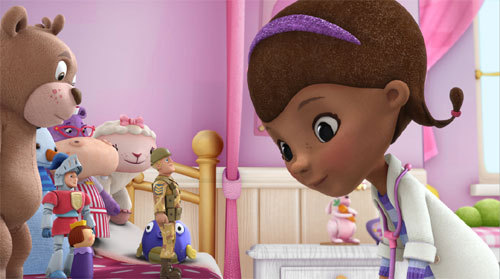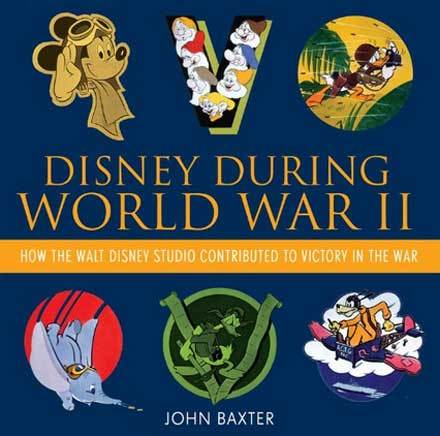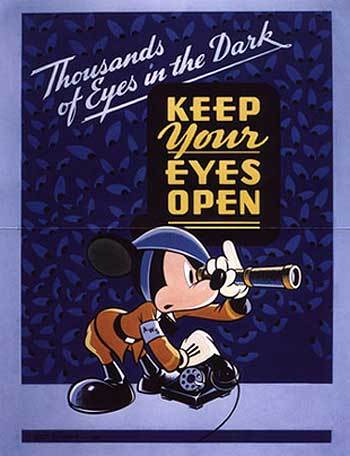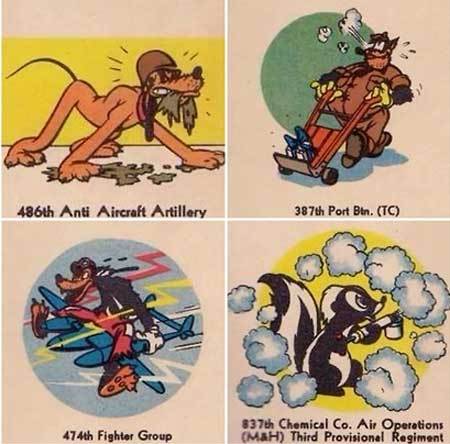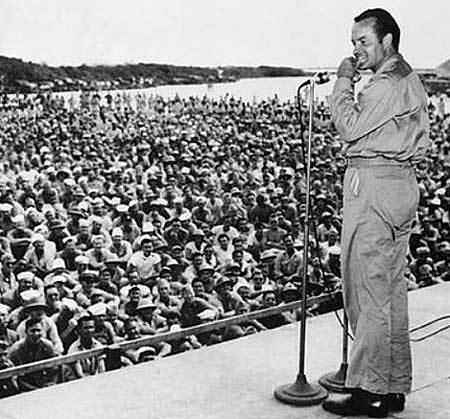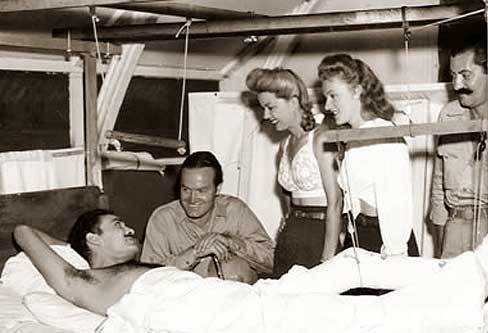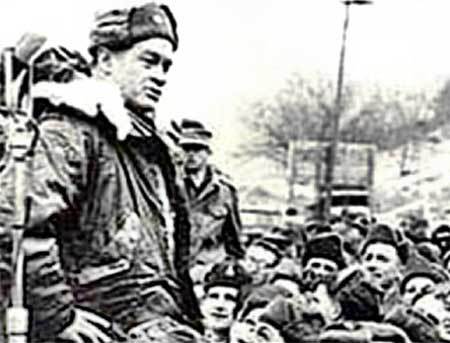As a former servicemember, I have to admit that I'm always intrigued by how various entertainment entities observe Veterans Day.
Take -- for example -- PBS. Their way of acknowledging that today is November 11th (i.e., the date that our nation honors all those who have served in both wartime and peacetime) is by airing a two hour-long documentary on the Navy Seals.
Meanwhile over at Disney Junior, they're showing a special episode of Doc McStuffins called "Training Army Al." Which deals with the emotions that young kids typically deal with when they have a parent or loved one in the military and that family member is then deployed.
Over at AMC, the focus is on America's more recent military operations with back-to-back screenings of The Green Berets, Heartbreak Ridge and We Were Soldiers. Meanwhile over at Turner Classic Movies, it's the Greatest Generation's greatest hits. With tonight's schedule at that cable channel piled high with World War II-era films like The Fighting Sullivans, Pride of the Marines and Patton.
Mind you, there used to be people in the entertainment business who genuinely did want to do right by our men and women in uniform. Who wanted to do more for these folks than just scheduling a night full of John Wayne movies.
Take -- for example -- Walt Disney. As John Baxter points out in his excellent new book, Disney During World War II: How the Walt Disney Studios Contributed to Victory in the War (Disney Editions, November 2014) ...
... When America's war began on December 7, 1941, the armed forces of the United States were suddenly in desperate need of efficient training methods to process the huge numbers of enlistees and draftees that were about to report to duty. Civilians with no relevant background experience had to learn how to be warriors and how to operate and maintain the increasingly complex aircraft, tanks, naval vessels, weaponry and other machinery of the period. Walt Disney helped the government meet that challenge by effectively transforming his studio from an entertainment factory that specialized in whimsy into a virtual war plant that churned out high-quality instructional films for the military nonstop for nearly four years, without profit and sometimes at a loss.
So why did Walt take on this difficult war-time assignment? To be honest, there was a practical component. As the clouds of war began gathering over Europe and Asia in the late 1930s, the revenue stream that came from screening Disney's animated features and shorts overseas began drying up. So to keep the Mouse Factory up and running during this difficult time, Walt and his brother Roy pursued dozens of government contracts and wound up producing training films for the U.S. Army and Navy as well as corporate clients like Lockheed.
But then there was the personal responsibility that Walt felt toward these men and women in uniform. After all, 10 years earlier, these soldiers, sailors and marines were the kids who had helped to make Mickey Mouse so hugely popular with Depression-era moviegoers.
Disney felt indebted to these folks. Which is why (again quoting from John Baxter's new book) ...
... perhaps the purest expression of Walt's genuine patriotism during the war years was his decision to establish a unite devoted to producing customized military insignia free of charge for the Armed Forces of America and her allies. Headed by the talented draftsman Hank Porter, whom Walt referred to as "a one man art department," the unit worked steadily throughout the war, turning out nearly 1,300 insignia upon request.
Just to be clear here: It wasn't just Walt Disney who went out of his way to do right by the troops back during World War II. As Richard Zoglin recounts in Hope: Entertainer of the Century (Simon & Schuster, November 2014), Bob Hope kind of redefined going out of your way when it came to America's men and women in uniform. Bob got his start doing this back ...
... in the summer of 1942, (when) one of Hope's former movie stand-ins, now an army sergeant, dropped by the Paramount lot and suggested that Hope pay a visit to the US troops stationed in Alaska, guarding the Aleutian Islands against a possible Japanese attack.
(That) Alaska trip made a powerful impression on Hope, and he talked soberly about it afterwards. "I wouldn't trade this trip for my last five years in show business - my lucky years," he told a reporter. "I tell you, a guy gets to seeing himself in the proper focus in a setup like that. It's touching that the visit from a mere human being can mean so much."
Having gotten his first taste of entertaining the troops, Bob made immediate plans to get back in front of that amazingly appreciative audience. Which is why -- as soon as Hope and Crosby wrapped up production of Road to Morocco and Bob had buttoned up his hugely popular radio show for its 1942 - 1943 season, during ...
... his summer radio hiatus in July and August of 1943, Hope made plans for his first overseas tour of military bases: a two-month trip to the British Isles and North Africa, under the auspice of the USO Camp Shows.
All told, (Bob) spent eleven weeks overseas, doing some 250 shows for an estimated 1.5 million men. He came back with scores of names and addresses scrawled on pieces of paper -- of the mothers and wives and sweethearts of the men he had entertained, who asked Hope if he would contact their loved ones and send greetings. Which he did.
That might have been enough for your average entertainer. But not Bob Hope. In June of 1944, he and a hand-picked team of pros headed off for the Pacific Theater. Where ...
... they stopped first in the Hawaiian Islands, where they spent nine days and did some thirty-five shows, the largest for twenty-five thousand civilian employees at the Pearl Harbor Naval Yards. Then they flew off to Christmas Island and began hopscotching islands on the "pineapple circuit."
The long trip back to the United States went through Wake Island and took fifty hours. In all, Hope's Pacific tour had encompassed thirty thousand miles and 150 shows in eight weeks.
And once World War II wrapped ... Well, that didn't stunt Bob's desire to do right by our men and women in uniform. Which is why as soon as the Korean War got underway in June of 1950, Hope immediately began making plans to head overseas to entertain the troops there.
This tradition continued for decades. Though ...
... by the early 1960s, Hope's annual Christmas tours to entertain the troops overseas were starting to draw some criticism ... Inside the military, some grumbled that Hope's tours were talking too much money away from other, more mundane but equally important projects. "Hope did a valid service. But it was an expensive project, and it took a good deal of the budget," said Dorothy Reilly, whose husband, Colonel Alvin E. Reilly, as head of entertainment and recreation for the Air Force, argued internally that the trips ought to be cut back. "That budget had to cover everything -- libraries, R-and-R centers. There were so many ways that money could be used." She couldn't forget the sight of thousands of GIs in Korea in 1957, waiting on a hillside for hours in the subzero cold while Hope and his troupe were preparing and rehearsing. "I thought it was kind of a selfish use of the military.
That's what's genuinely great about Hope: Entertainer of the Century. Richard Zoglin honestly doesn't pull any punches with this definitive biography of Bob Hope. He celebrates those moments where Bob -- just like Walt Disney -- really went the extra mile for our men and women in uniform. But as the same time, Zoglin isn't afraid to shine a spotlight on the more controversial aspects of Hope's career. Like his 1969 tour of Vietnam, where as Bob stood onstage and ...
... told the troops he had just been to the White House and assured them that Nixon had "a plan to end the war." He was greeted with boos.
So if you'd like to get the inside scoop on two Hollywood legends who did everything they could for the troops, be sure and pick a copy of John Baxter's Disney During World War II: How the Walt Disney Studios Contributed to Victory in the War and Richard Zoglin's Hope: Entertainer of the Century.

